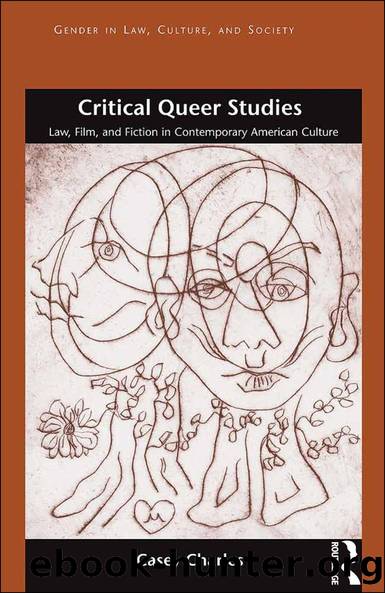Critical Queer Studies by Casey Charles

Author:Casey Charles [Charles, Casey]
Language: eng
Format: epub
Tags: Social Science, LGBTQ+ Studies, Gay Studies
ISBN: 9781317157090
Google: RgcGDAAAQBAJ
Publisher: Routledge
Published: 2016-04-22T05:08:49+00:00
Conclusion
Kate Bornstein, the transexual actress and author who came to Nebraska to attend the murder trials, writes, â[i]n living along the borders of the gender frontier, Iâve come to see the gender system created by this culture as a particularly malevolent and divisive construct, made all the more dangerous by the seeming inability of the culture to question gender, its own creation.â44 The myriad cultural and legal stagings that have erupted in relation to the Brandon phenomenon illustrate how the malevolent divisiveness Bornstein enumerates retains its stubbornness through the linking of gender to anatomy and sexual orientation. Not only do laws and outlaws in the Brandon Teena narrative police the regulatory alignment of sex and gender; they undertake that surveillance in the service of a compulsory heterosexism that is necessarily violated by a transgender subject whose anatomy comes under such surveillance. This power of enforcement or branding, I have argued, provides ironically enough the glue to hold the LGBTIQ continuum together, in spite of a set of internal contradictions within the coalition itself, and it is my contention that this collective discrimination against the queer subject can create a coalitional unity that struggles for change.
Do the cultural and legal documents that have arisen in conjunction with the story of Brandon Teena merely underline the divisiveness Bornstein laments, or might they reflect the beginning of a cultural and legal inquiry into our continued imprisonment by a gendered ontology, one which prescribes only one acceptable trajectory of desire? The troubling techniques of gender knowledge that this case history has producedâranging from defamation lawsuits to Hollywood love tragedy to critical inquiryâattest on the one hand to the commodification of and capitalizing on this curiously queer but true crime. At the same time the explosion of discourse that has accompanied Brandonâs story, including Supreme Court decisions and ground-breaking essays like those of Halberstam and Bornstein, also indicates that not every form of understanding is necessarily contained by a larger matrix of power.
âResistance to power,â Foucault wrote later in his life, âdoes not have to come from elsewhere to be real, nor is it inexorably frustrated through being the compatriot of power.â45 Brandon Teena herself was determined to be a man; that determination, however complicit with a notion of fixed heterosexual orientation and male gender identity, had the very real effect of subverting gender boundaries. At times, Brandon had to lie about his body in order to perform the truth of his masculinity, a truth that gave him the power to seduce, love, and legitimate his love of women. Yet this lieâwhich for Brandon is the only truthânecessarily produced a vigilant investigation and subsequent Hollywood quest narrativeâan apparatus of legal and cultural inquiry that investigated and discovered the truth about Brandon, a social and legal truth that branded him as tragic gender outlaw, âfreak,â and finally âdyke.â Nissen and Lotter became the unlikely and pitiful tools for returning Falls City to social normativity, a status quo which Aristotle calls âjustice,â by impinging the paradigm of
Download
This site does not store any files on its server. We only index and link to content provided by other sites. Please contact the content providers to delete copyright contents if any and email us, we'll remove relevant links or contents immediately.
Sex Workers As Virtual Boyfriends by Joseph Itiel(204)
Hijab Butch Blues by Lamya H(201)
Then There Was Her by Sophie Cachia(199)
A Trans Man Walks Into a Gay Bar: A Journey of Self (And Sexual) Discovery by Harry Nicholas(179)
Despite All Adversities by Lema-Hincapié Andrés;Castillo Debra A.;(174)
A History of Women in Men's Clothes by Norena Shopland;(167)
James Baldwin's Later Fiction by Lynn O. Scott(164)
Transgender Behind Prison Walls by Baker Sarah Jane Stockwell Pam(163)
One Marriage Under God by Melanie Heath(157)
Transgender Employees in the Workplace by Jennie Kermode(155)
Substance Use Disorders in Lesbian, Gay, Bisexual, and Transgender Clients by Sandra Anderson(151)
Lesbian Doms: 10 Women Describe Their Most Memorable Lesbian Domination Experience by Foster Kendra(148)
Patricia Highsmith's Diaries and Notebooks by Patricia Highsmith(146)
Visions of Sodom by H. G. Cocks(145)
Queer TV China by Zhao Jamie J.;(145)
Confronting Religious Denial of Gay Marriage by Wallace Catherine M.;(145)
Consumed by Desire (Central Park South Book 1) by Bianca Vix(143)
Who's Who in Contemporary Gay and Lesbian History Vol.2 by Robert Aldrich Garry Wotherspoon(138)
Lesbian Mothers by Ellen Lewin(136)
